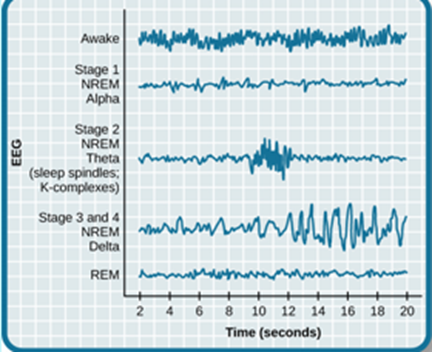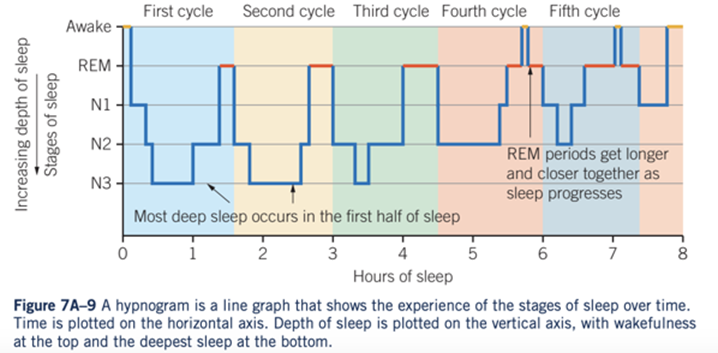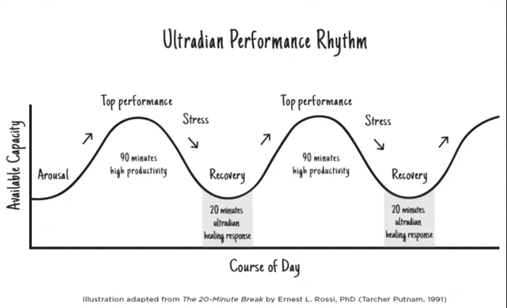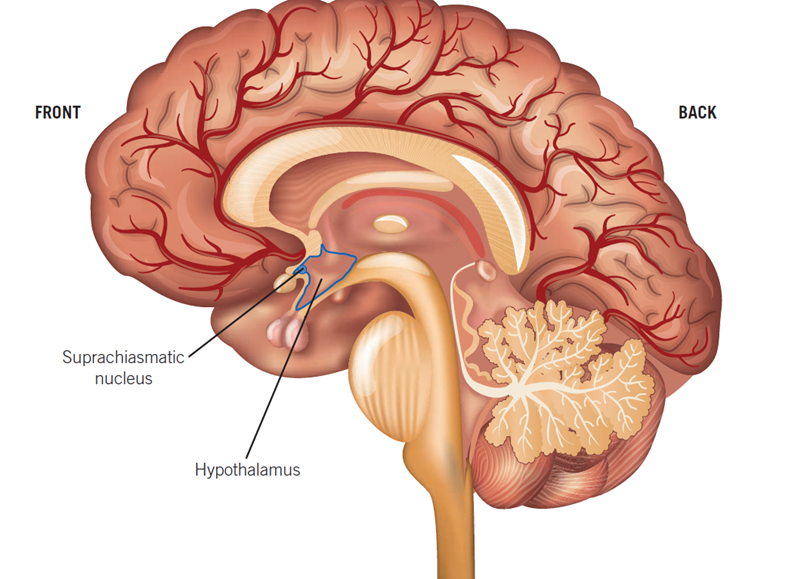Sleep as a State of Consciousness – Key Vocabulary
1/44
Earn XP
Description and Tags
Vocabulary flashcards covering key terms from Chapter 7 on sleep and consciousness, including sleep stages, measurement techniques, hormones, biological rhythms and lifespan changes.
Name | Mastery | Learn | Test | Matching | Spaced |
|---|
No study sessions yet.
45 Terms
Consciousness
Our awareness of internal processes (thoughts, feelings, sensations) and external events, continuously shifting along a continuum of awareness.
State of Consciousness
Distinct levels of awareness (e.g. fight of flight or freeze mode, fatigues, drowsy, daydreaming, asleep, in meditative state or under the influence of alcohol, medication and or an illegal drug) that differ in attention and responsiveness.
Normal Waking Consciousness (NWC)
- Also known as ordinary consciousness, refers to state of consciousness associated with being awake and aware of objects and events in the external world and one’s sensations, mental existence.
- Normal waking consciousness is not considered one single state, there are varying levels of awareness
- Most people spend 2/3 of each day in normal waking consciousness
Altered State of Consciousness (ASC)
Any condition of consciousness markedly different from NWC in awareness, perception or cognition; can be naturally occurring or induced. When changes in mental occur to the extent that you can notice difference in is alertness and your responsiveness to internal and external stimuli, you have entered an altered state of consciousness
Sleep (as a psychological construct)
A regularly occurring, naturally-induced ASC marked by reduced awareness, limited behavioural control and cyclic REM/NREM patterns.
REM Sleep (Rapid Eye Movement)
Sleep stage with rapid eye movements, vivid dreaming, high brain activity, virtual muscle paralysis, low levels of physical activity, low levels of somatic nervus system and ~20–25 % of a typical sleep episode.
NREM Sleep (Non-Rapid Eye Movement)
Sleep without rapid eye movement, divided into three stages with decreasing brain activity and increasing physical mobility; ~75–80 % of total sleep.
Sleep Episode
The full period of time spent asleep from sleep onset to final awakening, containing multiple sleep cycles.
Sleep Cycle
A ~90-minute ultradian rhythm in which the sleeper progresses through NREM stages 1-3 and REM sleep.
Characteristics of REM Sleep
Active brain, inactive body, vivid dreams, easy awakening, REM periods lengthen toward morning.
Characteristics of NREM Sleep
Reduced brain activity, possible body movement, less vivid dreams, dominates first half of the night.
NREM Stage 1 (N1)
Light sleep lasting 1–5 min featuring hypnagogic sensations, slow rolling eye movements and reduced physiological activity.
Hypnagogic State
Transitional experience between wakefulness and sleep marked by floating, falling or sudden jerks.
Hypnic Jerk
A sudden involuntary muscle twitch occurring as one drifts into NREM Stage 1.
NREM Stage 2 (N2)
Light-to-moderate sleep with sleep spindles, further slowed physiology and no eye movement; occupies most total sleep time.
Sleep Spindle
Brief burst of rapid brain activity on an EEG, characteristic of NREM Stage 2.
NREM Stage 3 (N3)
Deep or slow-wave sleep dominated by delta waves, hardest to wake, when sleepwalking/talking may occur.
Delta Waves
High-amplitude, low-frequency brain waves associated with deep NREM Stage 3 sleep.

Slow-Wave Sleep (SWS)
Another term for NREM Stage 3, characterized by delta wave dominance.
Hypnogram
- Line graphs that represent stages of sleep plotted against time

Electroencephalography (EEG)
Technique that detects, amplifies and records brain electrical activity via scalp electrodes to study sleep stages.
Electromyography (EMG)
Recording of muscle electrical activity to gauge changes in muscle tone during sleep.
Electro-oculography (EOG)
Measurement of electrical activity in eye-controlling muscles to track eye movements in sleep.
Beta Brain Waves
High-frequency, low-amplitude waves linked to alert wakefulness and REM dreaming.
Alpha Brain Waves
Medium-frequency waves seen when awake but relaxed and internally focused.
Theta Brain Waves
Lower-frequency waves typical of drowsiness and early sleep (N1, N2).
Delta Brain Waves
Slowest, highest-amplitude waves present in deep (N3) sleep.
Sleep Diary
- A ‘log’ used to self-record and self-report sleep and waking time activities over a period of time, usually a week or more
- Most often used in conjunction with physiological measures such as EEG and EMG it supports the assessment of sleep disturbances or disorders
a subjective measure as it is based on personal feelings
Video Monitoring
Use of audiovisual recording during sleep to observe behaviors such as movement, breathing or parasomnias.
Biological Rhythm
Regularly repeating biological process governed by internal mechanisms (e.g., circadian, ultradian).
Circadian Rhythm
24-hour cycle of physiological and behavioral processes, including the sleep-wake cycle.- There are biological mechanisms that help regulate the sleep-wake cycle, including the suprachiasmatic nucleus and melatonin
Ultradian Rhythm
Biological cycle shorter than 24 hours, such as the 90-minute sleep cycle.

Suprachiasmatic Nucleus (SCN)
An area of the hypothalamus that is responsible for regulating sleep-wake patterns. The SCN has two nuclei each containing approximately 10,000 neurons each and located above the optic chiasm (the intersection between the optic nerve fibers between the eyes). The SCN plays an important role in regulating the sleep-wake cycle by acting like an internal body clock. The SCN receives information from both external and internal cues to help modulate the circadian rhythm. Internal cues originate from within the body such as the expression or suppression of particular genes known as clock genes. External cues involve cues from our environment such as the absence or presence of light .

Melatonin
Information from our internal and external cues dictates the message sent from the SCN to the pineal gland, which is a gland in the brain responsible for the production and release of melatonin. At around 8-9pm, melatonin levels should reach a point which induce a sense of calmness, which promotes sleepiness, naturally causing one to fall asleep. Melatonin does not induce sleep bit rather promotes feelings such as calmness or relaxation that may cause sleep. The higher the melatonin levels, the more drowsiness. The amount of melatonin secretion into the bloodstream depends on the amount of light detected
Melatonin Feedback Loop
Process where the SCN detects blood melatonin and adjusts pineal output to maintain optimal levels.
Cortisol
Adrenal hormone that heightens alertness, peaking in the morning to promote wakefulness. The SCN is not responsible for releasing cortisol but rather, the adrenal cortex is
Sleep Across the Lifespan
Patterns of total sleep time, REM/NREM proportions and sleep onset that change from birth to old age.
Newborn Sleep Pattern
~16 h sleep/day with ~50 % REM; circadian rhythm not yet established; sleep often begins in REM instead of NREM stage 1. Sleep begins follow a more regular, circadian cycle at about 2-3 months in
Infant Sleep Pattern
12–13 h sleep with REM ~30–40 %; circadian rhythm develops, longer nocturnal sleep periods.
Child Sleep Pattern
About 11 h sleep; REM ~20 %, high proportion of slow-wave sleep; possible dropping of daytime naps.
Adolescent Sleep Pattern
8–10 h recommended; REM ~20 %; biological delay in melatonin release causes later sleep onset. Slow wave deep sleep has decreased by nearly 40%
Delayed Sleep Phase Syndrome
Shifted circadian timing in adolescents causing preference for later bedtimes and wake times.
Adult Sleep Pattern
7–9 h sleep with REM ~20 %; gradual reduction in slow-wave sleep; stable REM/NREM ratio.
Advanced Sleep Phase Syndrome
Tendency in older adults to feel sleepy earlier in the evening and wake earlier in the morning.
Older Adult Sleep Pattern
7–8 h total sleep, REM ~18-20 %, little or no NREM Stage 3, increased awakenings and sleep latency.